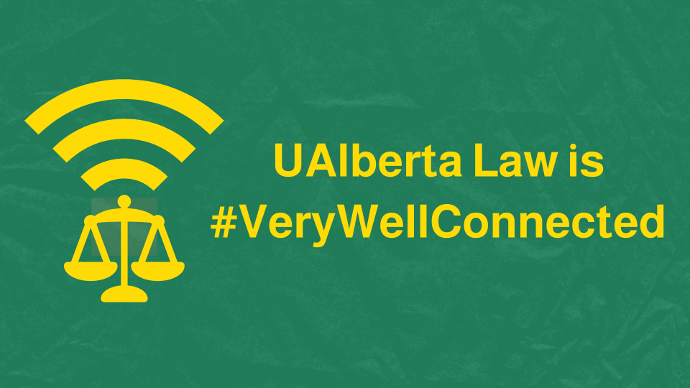#VeryWellConnected: How UAlberta Law created remote classes fast and fulsomely
Helen Metella - 25 May 2020

If there’s an apocalypse coming and your work must all be done digitally, protected by numerous fail-safes and Plans B through Z, then Tim Young is your guy — except the University of Alberta Faculty of Law will fight you for him.
Early in March 2020, a week before COVID-19 was declared a global pandemic and the NBA’s shutdown made us all take notice, Young was already putting finishing touches on updated how-to videos for law professors, preparing them to smoothly deliver their classes remotely.
The Faculty’s exam and online course system administrator, web developer, IT advisor and self-described “digital prepper” had been readying his tactics “every waking moment for months,” and actually laying the groundwork for years for something as unforeseen as social distancing regulations cancelling in-person classes abruptly.
“You try to avoid a single point of failure,” says Young, who has plied his formidable skills at the university for 20 years and at the Faculty of Law since 2004.
His thousands of hours of preparation included testing multiple streaming software programs to find their strengths and weaknesses, establishing backup servers, and creating remote access and delivery for administration purposes.
HOW-TO VIDEOS
By the time professors began teaching remote classes on March 17, Young had produced very clear, very brief instructional videos for everything from sharing screens during multimedia online presentations, to how to troubleshoot if equipment fails mid-class.
Throughout the last weeks of the spring term, Young was available for consultations everywhere. He gave patient, one-on-one instruction to students and faculty again and again. He sat in on remote classes and jumped to the instructors’ or students’ rescue while simultaneously muting his microphone so he could answer questions coming at him non-stop from Facebook, email, text and phone.
And for weeks, he had Google Meet open non-stop at his home “with the volume cranked so that if I stepped away and went to the kitchen and someone had joined the Meet, I could hear them, right away.”
In one case, “a student called me and said, ‘I’m presenting right now and have an emergency.’ His laptop had started updating and it was taking forever, at the worst possible time. I set him up to present through his phone.”
HOW TO PIVOT
Young pivoted rapidly. After discovering that YouTube live streaming was proving too technical for most Faculty users, he switched to recommending Google Meet and created videos explaining its features, instead.
With his skills in data recovery and computer repair, Young was also a guardian angel to the several students whose laptops failed during the term and the exam period, and to one whose laptop was stolen.
“I maintain a pool of loaner laptops I refurbish and a junk pile I salvage replacement parts from,” says Young. “I had them ready, sanitized, in plastic bags with mice, and gave out five or six.” Some of those were initially purchased by the Faculty, but others were donated by professors or former students, and Young is happy to accept more such gifts.
The exam period itself posed no technical challenges for Young, as he long ago implemented the best delivery option for Law (Exam4) and applauds the excellent work professors did in rewriting their exams to be open-book format.
Hearing about problems other universities and even other Faculties encountered — from unreliable remote connections to exam systems that were so clunky the exams were outright cancelled — Young gives top marks to Law’s community and its ability to continue delivering top-notch virtual class instruction.
“Even the most technically challenged of our faculty have done well with online presentations. They have been tested, they went through the ringer and they came out successful. As for next term, it will just be old hat. We’ve already got it in place.”